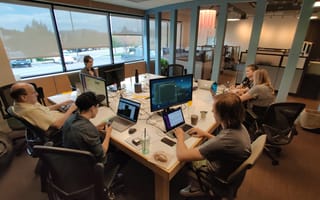When it comes to solving a puzzle, there are multiple plans of attack. You can start by building the border and working your way in, you can pile similar colors together, or if you’re part of a DevOps team, you might automate a software system to do it for you.
DevOps are responsible for creating communication between software development and IT systems teams so that the two departments can work together to create the bigger business picture. We asked two directors of engineering about the tactics they use to structure their teams to ensure that picture is frame-worthy.

By incorporating cloud-based software, FluentStream Technologies makes client communication easier and more manageable for small businesses. Director of Engineering Justin Davies explains why giving his DevOps team exposure to both voice technology and software automation tooling makes them experts at their jobs.
How have you structured your DevOps team, and why? What's the breakdown of roles and responsibilities?
Our DevOps team is structured to provide underlying infrastructure and service reliability. This involves supporting both our software development team and many of our more sophisticated clients. Additionally, our DevOps team has primary responsibility for our voice and telecommunications technology, so their resources include software automation tooling, and knowledge of how a voice network interconnects with our data and API infrastructure. While engineers specialize differently, everyone gets exposure to both areas of technology and can learn and apply those skills to problems in both domains.
Our DevOps team is structured to provide underlying infrastructure and service reliability.”
Please describe a recent DevOps win that resulted from this team structure.
We have had a number of successes that are built on our ability to operate this shared voice and Linux infrastructure. Unlike many players in our space, we are able to deliver 100 percent of our services on commodity infrastructure as a service, rather than having to invest in and maintain legacy hardware-centric infrastructure. This allows us much greater flexibility and allows us to share common tooling for deploying both API and a heterogeneous cloud environment. And our team gets to write a lot of Golang and Kubernetes deployments for voice services.

Building a software company that combines wearables, machine learning and blockchain means that there is a never-ending to-do list for Active Oversight’s Director of Engineering Quentin Hartman. He told us how a small DevOps team is an advantage when tackling big responsibility.
How have you structured your DevOps team, and why?
We’re quite small, and so we are an ideal organization for a converged DevOps practice. I lead the infrastructure and automation efforts, but we practice DevOps as a whole organization. One of the greatest examples of this is how we handle analysis of the daily metrics report from our production environment. It summarizes interesting stats from the previous day, including slow requests, request volumes and requests that caused errors. That responsibility rotates through the developers, so they all have a shot at it.
I lead the infrastructure and automation efforts, but we practice DevOps as a whole organization.”
Describe a recent DevOps win that resulted from this team structure.
We had an interesting day last quarter where a developer pointed out an unusual error on the report and was sure it was something we needed to look at more closely. I was skeptical, but he and I looked into it, and while it was weird, we couldn’t think of how it might have occurred or what impact it might have. Later that day, we got a bug report from one of our users that baffled our first-line support people. However, once it came to us, we knew exactly what the problem was because of the digging we had already done. In the end, we used varied perspectives to “pre-diagnose” this bug, and turn around a fix much more quickly than we would have otherwise.









